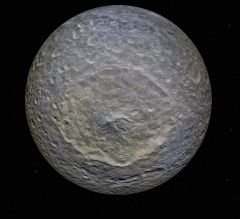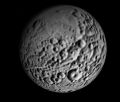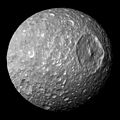Difference between revisions of "Mimas"
(Added tables, content.) |
(Added image to gallery.) |
||
| Line 70: | Line 70: | ||
MimasOrbiter2002.jpg|<center>Mimas in Orbiter 2002</center> | MimasOrbiter2002.jpg|<center>Mimas in Orbiter 2002</center> | ||
Mimas.jpg|<center>Mimas</center> | Mimas.jpg|<center>Mimas</center> | ||
| + | Mimas Cassini.jpg|<center>Mimas as seen by the [[w:Cassini-Huygens]] spacecraft on 13 February 2010<br>from Wikimedia Commons</center> | ||
</gallery> | </gallery> | ||
Revision as of 03:41, 1 August 2024
| Mimas | |
|---|---|

| |
| Mimas in Orbiter 2016 with D3D9 client | |
| Designation | |
| Name | Mimas |
| Reference body | Saturn |
| Planetary mean orbits | |
| Epoch | 1999.0 |
| Semimajor axis (a) | 1.743×108 m |
| Eccentricity (e) | 0.0206 |
| Inclination (i) | 1.564174781° (0.0273 radian) |
| Longitude of the ascending node (LAN, ☊) | 177.4450292° (3.097 radian) |
| Longitude of periapsis (ϖ) | 140.3230936° (2.4491 radian) |
| Mean longitude (L) | 240.4933049° (4.1974 radian) |
| Selected physical parameters | |
| Mean radius | 196000 km |
| Mass | 3.80×1019 kg |
| Rotation elements | |
| SidRotPeriod | 74239 seconds (20.622 hours) |
| SidRotOffset | 0 |
| Obliqutiy | 0.4895 |
| LAN | 6.09808 |
| Note | *Elements given are from Mimas.cfg (Orbiter 2002) |
Mimas [MY-mass] is one of the innermost moons of Saturn. William Herschel discovered the moon on 17 September 1789. The surface is icy and heavily cratered. Mimas has a low density, meaning it probably consists mostly of ice. Because Mimas has such a low temperature of about -200° C (-328°F), the impact features may date back to the time of the moon's creation.
One of the craters, named Herschel, is surprisingly large in comparison to the size of the moon. The crater is 130 kilometers (80 miles) wide, one-third the diameter of Mimas. Herschel is 10 kilometers (6 miles) deep, with a central mountain almost as high as Mount Everest on Earth. This central peak rises 6 kilometers (4 miles) above the crater floor. This impact probably came close to disintegrating the moon. Traces of fracture marks can be seen on the opposite side of Mimas.
Although Mimas is heavily cratered, the cratering is not uniform. Most of the surface is covered with craters greater than 40 kilometers (25 miles) in diameter but in the south polar region, craters greater than 20 kilometers (12 miles) are generally lacking. This suggests that some process removed the larger craters from these areas.
Mimas was named by Herschel for Mimas, the Titan who was slain by Hercules.
Mimas in Orbiter
Mimas was first introduced to Orbiter with the release of Orbiter 2002.
| Add-on | Source | Version | Author | Type | Release Date | Compatibility | Wiki article |
|---|---|---|---|---|---|---|---|
| Orbiter 2002 | O-F Resources | 020419 | martins | Orbiter Download | 19 April 2002 | Orbiter 2002 | |
Mimas as seen by the w:Cassini-Huygens spacecraft on 13 February 2010
from Wikimedia Commons
| edit The Solar System | |
|---|---|
| Central star |
Sun (Sol) |
| Planets |
Mercury - Venus - Earth - Mars - Jupiter - Saturn - Uranus - Neptune |
| Natural satellites |
Moon - Phobos - Deimos - Io - Europa - Ganymede - Titan - more... |
| Add-ons |
Planets - Dwarf Planets - Small objects - Natural satellites - Alternative star systems |
 | This natural satellite related article is a stub. You can help Orbiterwiki by expanding it.
|


